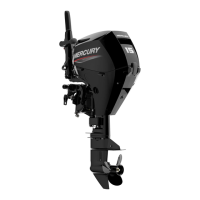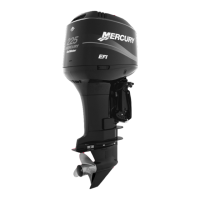FUEL INJECTION
Page 3B-14 90-883728 JULY 2001
Fuel Flow Component Description
Pulse Fuel Pump (d)
The pulse fuel pump operates through alternating crankcase pressure to deliver fuel
through the water separating filter to the vapor separator.
Fuel pressure @ Idle: 2 – 3 psi (13.8 – 20.7 kPa) [Minimum – 1 psi (6.9 kPa)].
Fuel Pressure @ Wide-Open-Throttle: 6 – 8 psi (41.4 – 55.2) [Minimum: 4 psi (27.6 kPa)].
Water Separating Filter (e)
The water separating filter protects the fuel injectors from water and debris. The filter con-
tains a sensor probe which monitors water level in the filter. If water is above the sensor
probe, the warning horn will begin a series of beeps.
Vapor Separator (h)
The vapor separator is a fuel reservoir which continuously blends and circulates fresh fuel
and oil.
a. Fuel Inlet – Fresh fuel delivered from the water separator by the crankcase
mounted pulse fuel pump. The amount of fuel allowed to enter the vapor separator
is controlled by a needle/seat and float assembly mounted in the cover of the vapor
separator.
b. Oil Inlet – Oil delivered by ECM controlled oil pump.
c. Fuel Pressure Regulator Inlet – Unused fuel/oil mixture being recirculated from the
pump back into the vapor separator.
Final Filter (n)
The final filter is located above the electric fuel pump in the brass fuel fitting. The filter col-
lects debris and prevents them from flowing into the fuel rail and injectors.
Electric Fuel Pump (Inside Vapor Separator) (j)
The electric fuel pump runs continuously while providing fuel in excess of engine de-
mands. The excess fuel is circulated through the fuel rail to the fuel pressure regulator and
back to the vapor separator. Normal fuel pressure is 41 – 45 psi (283 to 310 kPa).
Fuel Injectors (c)
The fuel injectors are located on the fuel rail. The injector valve body consists of a solenoid
actuated needle and seat assembly. The injector receives signals from the EFI Electronic
Control Module. These signals determine how long the needle is lifted from the seat (pulse
width) allowing a measured fuel flow. The pulse width will widen (richer) or narrow (leaner)
depending on various signals received from sensors connected to the EFI ECM. The ECM
receives a signal from the crank position sensor to fire each injector accordingly.
A 12 wire harness connects the fuel injectors to the ECM. The RED wire is at 12 volts and
connects to all injectors. The BLUE, YELLOW, WHITE, BROWN, PURPLE and ORANGE
wires each go to individual injectors and are normally at 12 volts for a zero differential. To
fire the injectors this voltage is brought down to near ground creating a potential across
the injectors.
Fuel Pressure Regulator (p)
The fuel pressure regulator is located on top of the vapor separator and is continuously
regulating fuel pressure produced by the electric fuel pump. The electric pump is capable
of producing 90 psi (621 kPa) of fuel pressure. The pressure regulator limits fuel pressure
at the injectors to 41 to 45 psi (283 to 310 kPa).
